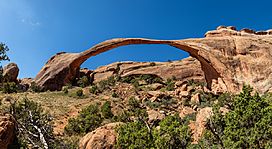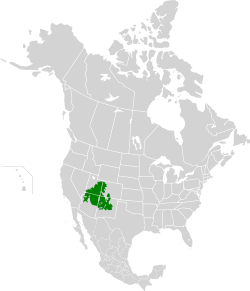Colorado Plateau shrublands facts for kids
Quick facts for kids Colorado Plateau shrublands |
|
|---|---|

|
|

Location map of Colorado Plateau shrublands
|
|
| Ecology | |
| Realm | Nearctic |
| Biome | deserts and xeric shrublands |
| Borders |
List
|
| Geography | |
| Area | 283,435 km2 (109,435 sq mi) |
| Countries | United States |
| States | Arizona, Colorado, New Mexico and Utah |
| Conservation | |
| Conservation status | Relatively stable/intact |
| Protected | 33,203 km² (12%) |
The Colorado Plateau shrublands is a special natural area in the western United States. It's a type of ecoregion known for its dry lands and shrubs. This region is home to many unique plants and animals.
Contents
Where are the Shrublands?
This amazing place is found on the Colorado Plateau. Most of it is in the area around the upper Colorado River. It also stretches into the upper part of the Rio Grande river basin.
Plants of the Plateau
The Colorado Plateau shrublands have three main types of plant areas. These are woodlands, mountain woodlands, and grasslands with shrubs.
Woodland Zone
The largest area is the woodland zone, also called the pinyon-juniper woodland. Here, you'll find open forests with short trees. These trees are mostly pinyon pine and different kinds of juniper. The ground has thin patches of grass, like grama grass. You can also see herbs and shrubs such as big sagebrush.
Arid Grasslands
Lower areas have dry grasslands. Here, grasses, sagebrush, and other shrubs are common. Some spots have bare soil. In the warmest parts, you might even find cacti and yucca plants.
Mountain Zone
The mountain zone includes the high plateaus and mountains. This area has woodlands and forests. In the south, you'll see ponderosa pine trees. Further north, there are lodgepole pine and quaking aspen trees.
Animals of the Plateau
Many different animals live in the Colorado Plateau shrublands.
Large Mammals
You might spot large mammals like mule deer and cougars. Coyotes and bobcats also roam here. The gray fox is another resident. In some areas, you can find Rocky Mountain elk. In the dry grasslands, Pronghorn are the most common large animal.
Smaller Mammals
Smaller creatures include the North American porcupine and the black-tailed jackrabbit. You might also see mountain cottontail rabbits. Different types of chipmunks and rock squirrels live here too. The Bushy-tailed woodrat and white-footed mouse are also common. Sometimes, you might even spot a ringtail or a western spotted skunk.
Birds of the Sky
Many birds call this region home. Some common birds are the American bushtit and the pinyon jay. You can also see Woodhouse's scrub jays and juniper titmouses. Larger birds like the red-tailed hawk and golden eagle fly overhead.
During summer, birds like the chipping sparrow visit. The common nighthawk and black-throated gray warbler are also summer guests. In winter, you might see different kinds of juncos. The mountain bluebird and American robin are also common winter visitors.
Reptiles
Reptiles like the greater short-horned lizard live here. You might also find the western rattlesnake.
Protected Areas
A lot of the Colorado Plateau shrublands are protected. About 12% of this special ecoregion is set aside as protected areas. These places help keep the plants and animals safe.
Some of these protected areas include:

